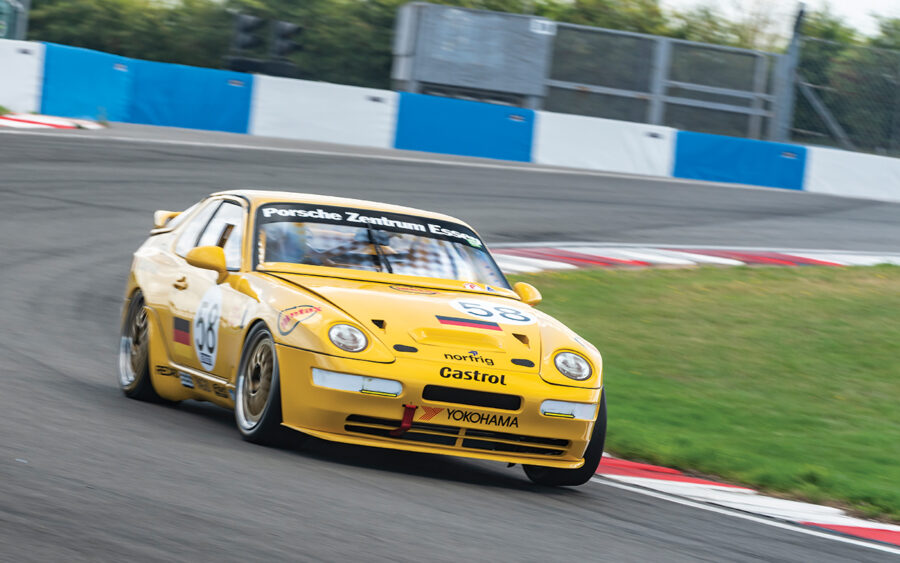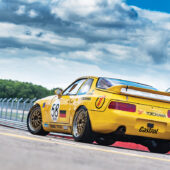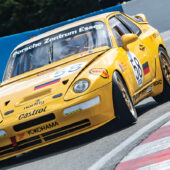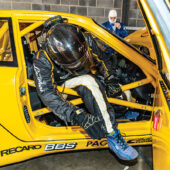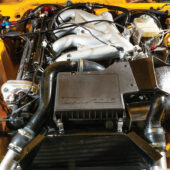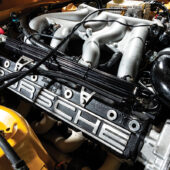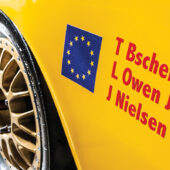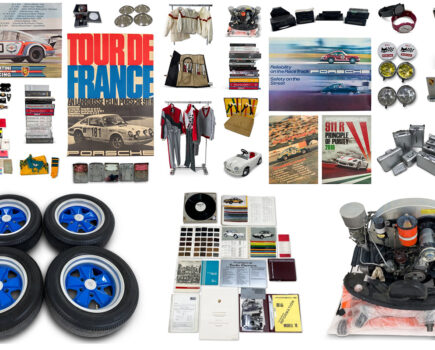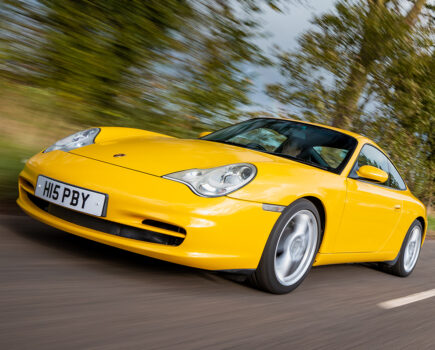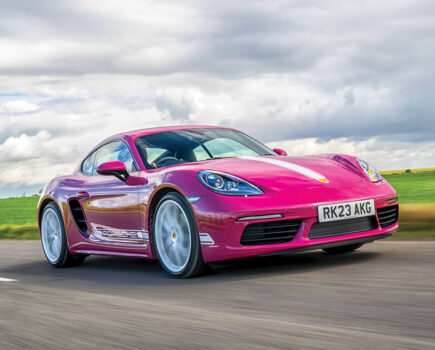The Porsche 968 RS was a contender for the GT2 class at Le Mans in 1994. We sample a faithful replica to see what the ultimate 968 is like on track
Words: Johnny Tipler Images: Antony Fraser
It’s a tough call, recreating an authentic Le Mans car, but the great thing about basing it on a 968 CS is that, in this case, much of the hard work has already been done for you. We’ve come to Donington Park circuit on a blustery test day to follow the fine tuning of a 968 Turbo RS, a fabulous tool-room copy of #58, the Seikel Motorsport car that ran at Le Mans in 1994. The issue now, though, is what race series it belongs in.
Before focusing on our feature car, let’s place it in context. Setting the scene for the 1994 Le Mans 24-Hours, which it celebrates, the demise of the World Sportscar Championship a year earlier, due to spiralling engine costs that deterred even works teams such as Mercedes and Peugeot from competing, had thrust GT racing into the limelight once more. Typically, the organisers, the AC de l’Ouest, with its fancy Indices of Performance and Thermal Efficiency, was not slow in devising an equivalency formula that allowed production-based GTs to compete directly against the LMP prototypes and IMSA WSC cars. The regs called for 25 units to have been built to qualify for GT1 and 200 units for GT2. While the Seikel 968 Turbo RS was a shoo-in for the GT2 class, Porsche themselves shrewdly revived a pair of 962s and entered them in GT1 under the auspices of German fashion magnate Jochen Dauer – and ended up 1st and 3rd in the race.
The 968 Turbo RS, on the other hand, crashed out after just 84 laps. There were 18 classified finishers from 48 starters, with the highest-placed GT2 cars, both 3.8-litre 993 RSRs, in 8th and 9th places. As for Dauer, they sold no less than twelve 962s on the strength of their victory. On the whole, front-engined Porsches never played much of a front-line role in top-line motor sport: sure, the 924 Carrera GT debuted at Le Mans in 1980 and in GTP and GTR format in ’81, then a singleton 928 raced in ’83, and let’s not forget the significance of the 944 Turbo Cup that introduced the Carrera Cup and ran from 1986 to 1989. Like the 928, production of the 968 ended in 1995, so this was something of a swansong.
As for the 968 Turbo RS, between 1992 and 1994, Weissach constructed four full-race versions based on the 968 Turbo S for its customer race teams. We are in extraordinarily rarefied territory here: Porsche produced only 14 units of the 968 Turbo S – and just the four Turbo RSs, three of which were racing cars, the fourth a road car. There were two slight variations in spec, one built to the national ADAC GT regs, ballasted by 150kg to match the 1350kg minimum weight limit and developing 337bhp using the K27 turbo from the Turbo S, and a lighter 350bhp version employing a KKK L41 turbo, developing 369 lb ft torque @ 3000rpm, weighing in at 1212kg, and aimed at wider race applications.
As well as the weight differences between the Le Mans GT-2 and the ADAC GT versions, the ADAC cars’ 5th and 6th gears were also shorter. The endurance cars had a larger fuel tank with fast-acting refueling valves and air-jacks. Chassis numbers of the four cars were WPOZZZ96ZNS820065 in Guards Red, WPOZZZ96ZPS896061 in Speed Yellow, WPOZZZ96ZPS896062 in Black, and WPOZZZ96ZPS896063 in White, making them the rarest 968s of all. Why only four? I asked the maestro himself, Jürgen Barth. “Yes,” he attests, “these cars were built in my Customer Sports Department in Weissach at the same time as the 964 RSR 3.8 for the ADAC GT and other GT Series like BPR, but only four 968s were built because the 911 was demanded more. I personally like it very much, but in the end, it was the customer’s decision; not enough people wanted it.”
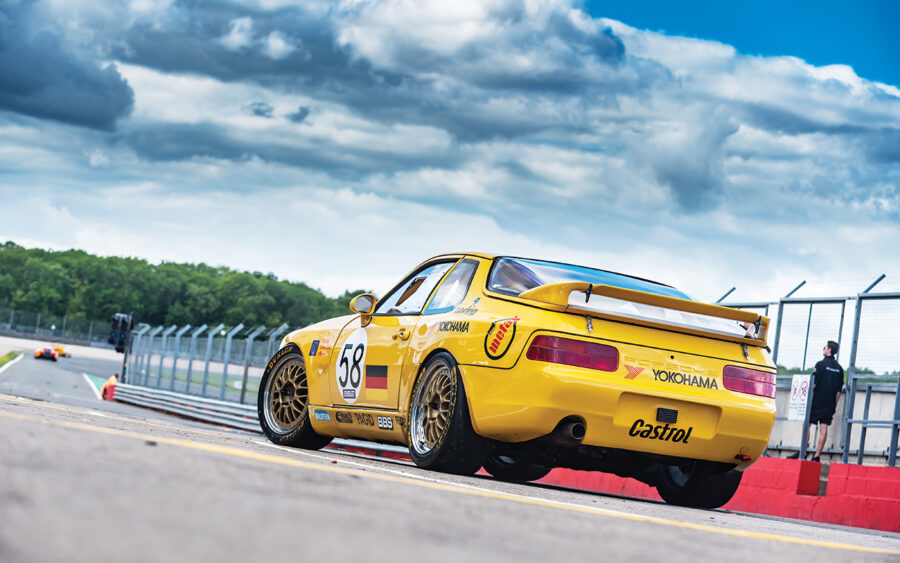
To complete the picture of the original car, ’94 Le Mans 968 Turbo RS, chassis 820065, was completed at the end of 1992 and served as a development car. Porsche then loaned it to Reinhold Jöst’s team, which was waiting for its own car, number four. Entered for the first ADAC GT race in 1993, still in red but with yellow front panel, it was driven by Manuel Reuter at Avus and finished 4th behind a pair of BMW M3 GTRs and Seikel Team’s Honda NSX. After its retirement at Zolder it remained in the factory the rest of the year, and was farmed out to Seikel Motorsport for Le Mans in ’94. Seikel Motorsport was founded in 1968 by Peter Seikel and was active in touring car and GT racing until 2007. Highlights included winning the 1980 constructors’ title in the European Touring Car Championship, and running a Honda NSX in the DRM series.
From 1994 Seikel espoused Porsches, and that’s where the 968 Turbo RS comes in. Its driver line-up for the 1994 Le Mans 24-Hours was Dr Thomas Bscher, who was a banker and semi-pro driver; Sir Lindsay Owen-Jones, a talented amateur driver and, incidentally, chairman and CEO of L’Oréal cosmetics; third pilot was Dane, John Nielsen, who’d won Le Mans in 1990 and was at the top of his game; the following year he and Bscher won the BPR Global GT Series in a Dave Price Racing McLaren F1 GTR-BMW. Thereafter, still in its ’94 Le Mans yellow colour scheme, the 968 Turbo RS was sold to Lloyd Hawkins in the USA, placing 18th in the 1995 Sebring 12-Hours. It participated in other IMSA races and could have won its last race at Road Atlanta in 1996 but for a broken turbo. It has since been restored in its original red paint and was auctioned at Amelia Island seven years ago for $346,500. It resides in Louisiana, and shows up at US Porsche meetings.
Our feature car, then, is a faithful copy of the red one, which – paradoxically – was painted yellow for the 1994 Le Mans 24-Hours. To gain FIA papers it needed to be based on a 968 Club Sport, and was then equipped with a turbo and intercooler. It’s the correct 8-valve engine, rather than the 16-valve, which is good for providing low-down torque. The car was built by Andy Jebson of Podium Preparation, based at Market Rasen, who converted it from a semi-race Club Sport. “He knows Porsches inside out,” comments test driver, instructor and racer Roberto Giordanelli, who’s fettling the car. “The build period lasted 18 months from start to finish. He sourced all the parts, and was very particular about them all being accurate, and the idea was to ensure that it was built exactly the same as the original Turbo RS race car because ultimately it needs FIA papers in order to run in a race series.” It’s run by John Danby Racing, based at Marks Tey, Colchester, with a staff of 10 techies.
Here at Donington Park, Roberto performs some fine tuning ahead of an upcoming race at Thruxton. It’s early days, though the car will be a contender in the Masters Endurance Legends and British GT Cup Championships. Roberto is optimistic: “They race 968 Turbos in America where they get up to 1000bhp out of them, but they can have huge cooling holes in the front whereas for FIA races we’re only allowed the original front air intake apertures.”
The intercooler is in front of the radiator, as is normal, and provided the intercooler is fenced and ducted, the air that goes through the intercooler then has to go through the water radiator. “That’s how you get the horsepower,” explains Roberto, “because the charge temperature determines how much boost you can run and how much power you’ve got, because a big intercooler gives us the horsepower.” There’s not much space to spare under the bonnet: there’s the intercooler of course, and the twinned manifolds, 1 and 4 and 2 and 3, and the turbo is on the opposite side of the engine so they have quite a long way to go to reach it.
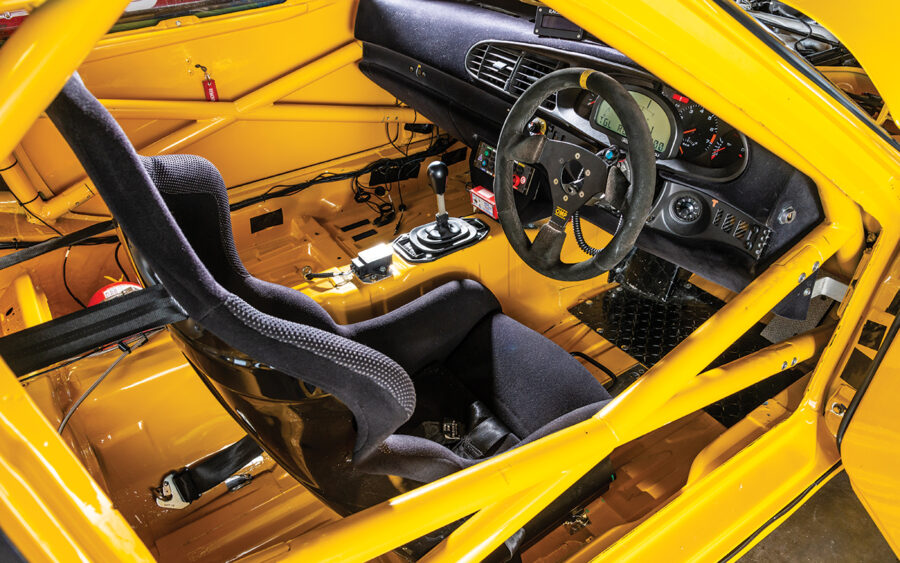
The car’s light weight comes into play, too: “it’s 1096kg to be precise,” says Roberto. “A road-going 968 Club Sport is about 1350kg. It’s got ABS but there’s no operational traction control. It doesn’t need traction control because it’s got so much grip anyway; it just puts the power down and goes off like a stabbed rat,” enthuses Roberto. “The ABS is useful, but you can hardly feel it; you just stand on the pedal. I’ve not seen a power curve from a dyno, but I can tell by driving it that it’s very good. It’s a six speed, of course, and it’s got a shift light and a rev limiter.”
As we know, the 968 is a driver’s car, especially in Club Sport format, and more driver-friendly than almost any other Porsche. Roberto’s own Porsche happens to be a 968 Sport, which is a Club Sport with a few creature comforts factored back in, such as rear seats, electric windows and central locking. The 968 Turbo RS is a rather different matter though, and there’s a lot more power. Roberto describes how he deploys it: “because it’s a turbo you have to drive it in a turbo kind of way, so you go flying into a corner, heel-and-toe brake into the corner so you carry your speed, and you’re straight back on the throttle, even though you don’t want to accelerate too hard, just enough to keep the turbo up, so that when you get to the exit point of the corner, it goes, so there’s no turbo lag.”
The car’s owner, Simon, takes up the case: “It’s a tricky thing to do, just to feather the throttle to make sure you’ve got the turbo going, because if you haven’t you’ve only got about 250bhp, and when the turbo is going you’ve got 500bhp, so you don’t really want that coming in all at once because it can upset the car a bit. In that case, because we use data for the entire length of the next straight, we can pinpoint a chunk of time lost by making a mistake, like not having the turbo up to speed before you get to the corner exit. You’re using the throttle carefully, feeling the car responding, and you gradually put some throttle on and get a little bit of impetus at the slowest point of the corner, so that the turbo starts spinning at good speeds when you want real power available; the usual turbo kind of driving.
“As for turbo lag, if you slow a car right down and then open the throttle wide open, the turbocharger turbine that runs at 120,000rpm has dropped to nothing, and it won’t produce power until that turbine is going at speed again, so when you open the throttle again there’ll be turbo lag. The latest technology has reduced it to the point where it’s almost gone away, but being old school turbo, you drive it accordingly; you normally get partially on the throttle before the apex, as you finish braking. The 968 Turbo RS is a very fast car and easier to drive than a 911; with this car you don’t care if you exceed the adhesion limit because it’s easy to control, unlike a 911 which you’re not really supposed to throw sideways, and if you get a fright and you lift off the throttle, this does nothing too dramatic, in fact it sorts itself out.”
The most difficult aspect of the build was sourcing the right turbocharger: “There were only so many road-going 968 Turbos built, and it wasn’t just a straight bolt on from a 944 Turbo; that was the major issue, finding somebody who knew about them, so we went to a turbo specialist in the States and gave him the parameters and he built the turbo to suit the car. In the States, their development of front-engined Porsches is further down the road than it is in Europe: they raced the 924 GTR and they stayed with the 944 and they carried on developing the cars, and it was a major success.”
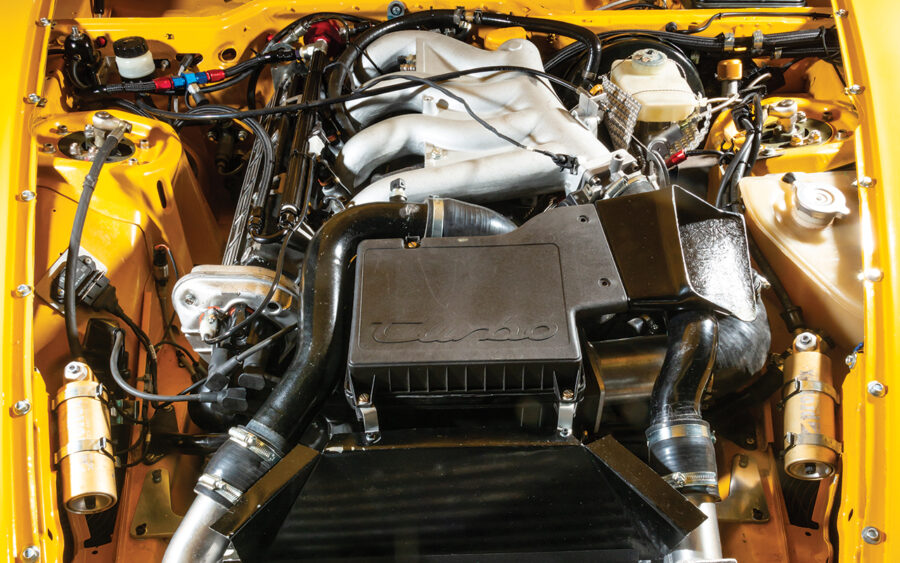
The glassfibre bonnet is slightly warped down the left-hand side due to the heat from the turbocharger, which has distorted the panel gap. “It’s on the move the whole time so we don’t mind, because it helps disburse the heat, although we did have a marshal radio in saying the bonnet is coming up, although it is perfectly secure.”
The front tyres covering the enormous split-rim, three-piece, centre-lock 10x18in and 11x18in BBS wheels appear to be hard against the bodywork. “That’s absolutely fine; the bodywork has moved a little bit, but this is no problem at all because the suspension moves the wheels inwards on bump.” And the Dunlop slicks, as opposed to the period Yokohamas stickered up on the car? “Yes, we’re trying to get some slicks from Yokohama, and they’re just coming back into the market so we’re hoping we can get some so they match the stickers.”
There’s a single Recaro race seat swathed with a full Schroth harness. Accessing the cockpit means scaling relatively high door bars. “I’m notorious for having the minimum of roll cage,” declares Roberto. “This is quite awkward to get in and out of. The steering wheel doesn’t come off, so I slide the seat back and it’s bum in first and you work your legs in over the door bars, and once you’re in you move the seat to where you want it. We’ve got two controls to the left of the steering column, one controls how much ABS you’ve got, and our pit lane speed limiter is the button on the OMP wheel. If it runs hot for some reason you’ll get a warning on the dash, the system will also reduce the boost to save the engine. We have progressive shift lights, we’ve got forward-facing and sideways cameras, and we have a Race Logic data logger so after a run we can investigate the data so we know exactly what’s gone on with the car: all the parameters are there, including what the driver is up to, so there’s nowhere to hide because it’s all recorded!”
The two cylinders either side the rear footwells are adjusters for the dampers, and there’s a plumbed-in fire extinguisher and a red button and switch to activate it. There’s also an enormous accelerator pedal. “That’s because I had the pedal mechanism fall to bits during a race once, and up above the linkage is a tiny connector which I had to use as a throttle, working the throttle with my big toe to finish the race.”
So far they’ve raced it at Silverstone and Rockingham, and scored a win at Oulton Park. They were invited to Spa Classic by Peter Auto, not to race, but to take part in some demonstration laps – “so it was sharing the track with the likes of the Bentley Le Mans winner, and for obvious reasons it certainly attracted a lot of interest from the Germans there.”
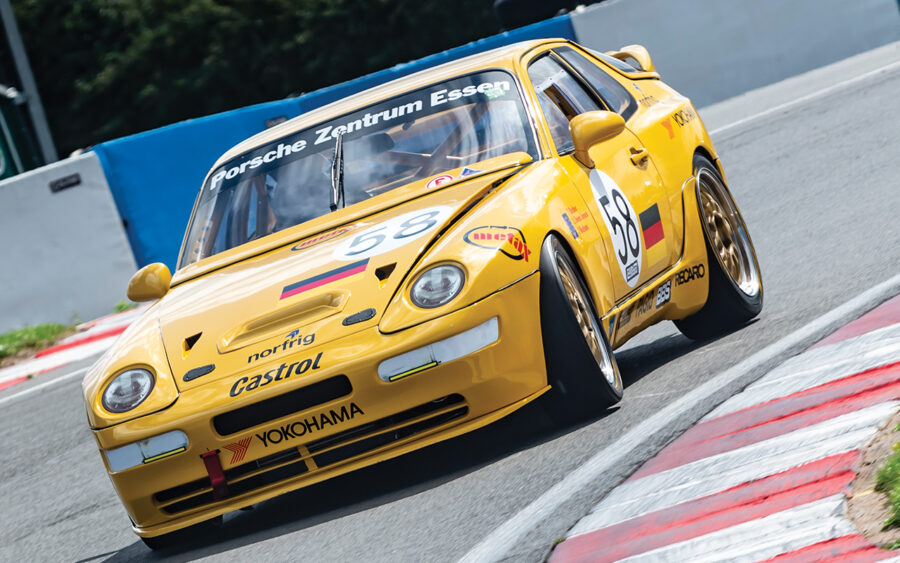
There’s some disenchantment with the available championships they can do. “It’s eligible for Masters Endurance Legends, but that series seems to have been hijacked by LMP1 cars – 2010 Le Mans cars – and the 968 is a 1994 car, so the speed differential is just a little bit too much to contend with; at the end of any particular straight we can get up to about 160mph, but things are coming past us at 210mph.
“So whilst other cars in the same category should be racing in that series, nobody has gone there, everybody has pulled out, so Ferrari 348s and 355s – which were GT2 cars back in the day – none of them want to race with the big boys because of the speed differentials; when you’ve got an 80mph differential on the straights and in the corners, that’s a massive amount of difference when you’re running hardly any aero and all those cars have mammoth amounts of aero, so they’re taking corners and straights far quicker. So that’s a shame because the series was perfect for the 968, and it’s pretty much why we built it. Chances are, we won’t run it there unless there’s enough interest from other parties and they all come out to play. It is disappointing, but I’m confident that a series will come to the car.”
Roberto thinks Peter Auto invited the car to Spa because they’re trying to do the same thing – to set up an endurance series for GT cars. So, maybe Peter Auto will come good with a series just for GT1 and GT2, and then the 968 Turbo RS will have found its home.

